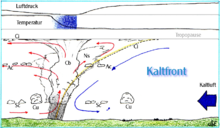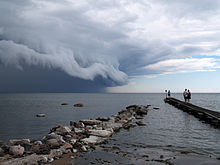Cold front
![]()
The title of this article is ambiguous. For the punk band see Kaltfront (band).
The cold front, like the warm front, is a weather phenomenon associated with an area of low pressure. The cold air moves here in the direction of the warm air. The cold front normally results in a cooling in all heights of the air layers. However, a distinction is also made between fronts in which cooling only occurs in higher air layers. This is called a high-altitude cold front. Furthermore, it can happen in winter that the cooled air mass near the ground is replaced by somewhat milder maritime cold air. Thus it becomes even warmer in the layers near the ground. This is called a masked cold front.
Furthermore, a distinction is made between cold fronts according to the flow behaviour of the cold air in relation to the warm air. In the case of the first type of cold front (anafront), the cold air pushes under the warm air and in the case of the second type of cold front (catafront), the cold air pushes over the warm air; for further explanation see below.
Cold fronts are characterised by increased vertical air movements. The resulting convective cloud cover often leads to shower-like intensified precipitation or thunderstorms. The arrival of a stronger cold front can often be easily observed: Quite strong, somewhat cooled wind, source clouds (possibly already some cumulonimbus clouds) announce it. The temperature drops by several degrees during the passage, it can even happen that after a beautiful spring day with 16 °C there is snow the next day after the passage of the cold front.
On the back of the cold front (cold sector), the atmosphere is usually unstably stratified. Together with the ground, which is still damp from the rain, this leads to the formation of cumulus clouds and showers under the sun's rays, the so-called backside weather. Furthermore, the air pressure increases again after the front has passed. Because the air is absolutely and relatively less humid than before the precipitation, the air becomes clear and visibility good. Once the cold front has caught up with the leading warm front, an occlusion forms.
On a weather map, cold fronts are indicated by blue triangles pointing in the direction of migration.
Symbol of the cold front on weather maps

Illustration of a cold front passage of the first type (anafront)
Anacalt front
According to classical theory, cold air gets under warm air, causing convergence at the air mass boundary. Here, the warm, moist air is forced to rise. The result is cloud formation and precipitation behind the cold front.
In the illustration, the cold air advance is from the right; the pressure and temperature curves, on the other hand, are set in mirror image.

In summer a cold front passage is often accompanied by thunderstorms
Cataclysmic Front
In the case of the catacalt front, the cold air gets over the warm air. The rise of the warm air is thereby prevented by the sinking of the dry air. Thus, also the cloud development, which takes place in front of the cold front, is kept small.
Questions and Answers
Q: What is a cold front?
A: A cold front is a meteorological term that describes cooler air mass moving into an area of warmer air, causing upward motion and lowered pressure.
Q: What happens when the denser cool air moves under the less dense warm air?
A: The cool air lifts the warm air, causing showers, thunderstorms, or a squall line to form.
Q: How is the surface position of the cold front marked on weather maps?
A: The surface position of the cold front is marked with the symbol of a blue line of triangles/spikes pointing in the direction of its movement.
Q: What is the difference between the speed of a cold front and a warm front?
A: Cold fronts can move up to twice as fast as warm fronts.
Q: What are some effects of cold fronts?
A: Cold fronts can cause temperature drops, strong winds, thunderstorms, and heavy rain.
Q: What weather conditions can accompany the formation of a cold front?
A: The formation of a cold front can cause a line of showers and thunderstorms or a squall line to form when there is sufficient moisture.
Q: What is the mechanism that causes lowered pressure along the cold front?
A: The upward motion of the warm air causes lowered pressure along the cold front.
Search within the encyclopedia